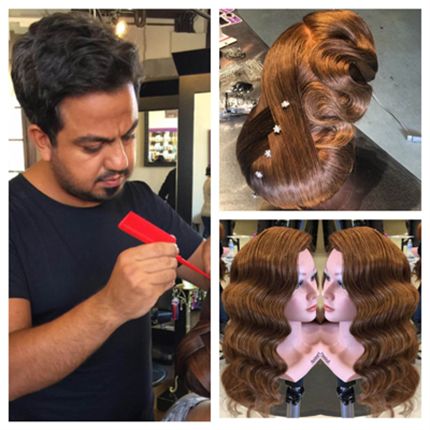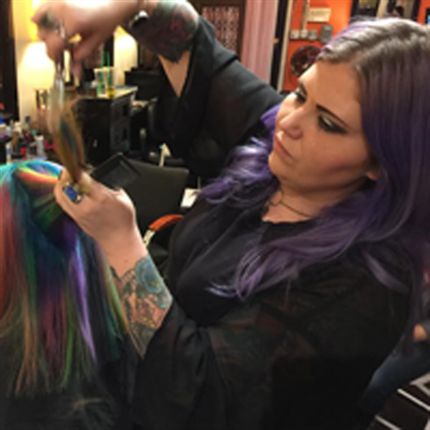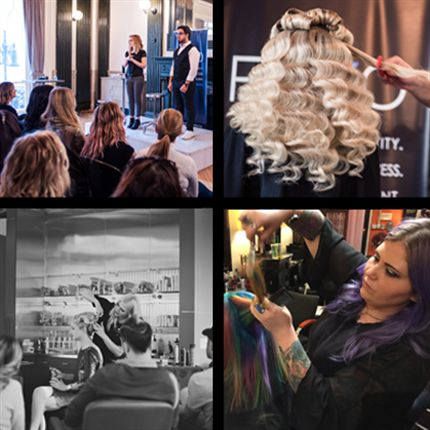6 Need-To-Know Tips For Independent Educators
These days, it seems like more and more stylists are packing up their hair kits, grabbing their phones and hitting the road to go get their teach on! But how do you cross over from working behind the chair to teaching behind the chair? And how do you do it on your own terms?
We all know the independent education movement is becoming more common in the industry, so BTC went to some of the most well-known traveling stylists to seek all their secrets! From finding a host salon, to structuring classes and using social media to kick start it all—we have six can’t-miss tips for independent educators looking to hit the road.

Mustafa keeps his Instagram purely related to hair. He wants his followers and students to know he keeps it completely professional on that platform.
1. Clearly Define Your Brand On Social Media
“My posts are as clear as possible,” says Mustafa Avci (@hairsalonm). “Everyone who comes to my site or page knows I am first and foremost a stylist. No personal pictures, no pictures of food. I just want everyone to know who I am and what I am doing as an updo artist.”
2. Practice, Practice, Practice
If you haven’t received formal training as an educator, practice is essential. “Even when I’m working with my regular clients in my salon, I like to educate them,” says Mustafa. “It really helps me feel more comfortable when I’m onstage explaining what I do.”

Mustafa and Stephanie recently taught a class together in New York City. Working with another stylist is helpful when you’re just starting to educate and it’s always a good time!
3. Co-Educate
“If you’re just starting out, consider teaching with someone else,” suggests Stephanie Brinkerhoff (@hairandmakeupbysteph). “It’s especially helpful if the person is located in the city you’re visiting. Chances are they’ll know the area and the venues, and they’ll take some of the pressure off of you to do and know it all.”
4. Always Evolve
As an educator, you have a responsibility to keep your material fresh and up-to-date. Offer value to your students and your hosts by challenging yourself to keep coming up with ideas and new approaches.
5. Charge What You’re Worth
Don’t be afraid to charge a high price when you can offer a valuable service with multiple takeaways. Quality goes a long way with these classes!
Check out what some of today’s most popular independent educators are charging: Stephanie Brinkerhoff charges $100 per person and up to $5,000 for a private, multi-day class. Mustafa’s classes start at $400 per person. Rebecca Taylor usually charges $500 per person and Jenny Strebe (@theconfessionsofahairstylist) charges $150 to $200 per person for the demo portion of her class and $300 to $400 per person for a full day class with a hands-on portion!

Rebecca Taylor has taught classes in more than 30 cities throughout the U.S. and around the world!
And of course we had to have a tip for all the students out there! Rebecca Taylor (@rebeccataylorhair) shares a big piece of advice for when you are deciding if a class is right for you.
6. Do Your Homework
“I can’t stress enough to stylists who attend these classes that it’s up you to research and gauge the educator’s value and credentials,” says Rebecca. “Literally anyone can promote on social media and line up a class. There are amazing stylists out there who may not necessarily be able to relay their knowledge in a way that’s easy for their peers to understand. There are a lot of presentation and communication skills needed, along with a firm grasp of chemistry and an understanding of how hair and products function in order to be a well-rounded educator. Protect your investment!”
More from
Mustafa Avci
-
#thebtcshow 2019
#THEBTCSHOW 2019: DAY 2
-
THE BTC SHOW 2019
Matrix At #THEBTCSHOW 2019
-
Balayage
THE BTC SHOW 2018: Day 1
-
#THEBTCSHOW 2018
Matrix at #THEBTCSHOW 2018
-
Styling
Master @mustafaavci’s Signature Glam Waves With These 6 Tips
-
Styling
WATCH: Mustafa Avci’s Hollywood Waves
-
Styling
5 How-Tos For Old Hollywood Glamour
-
#thebtcshow Austin 2017
The Behind The Chair Show 2017: Day 1
-
#thebtcshow Austin 2017
b3 at #thebtcshow
-
Hair Extensions
Vintage Waves With Extensions
-
News
The BTC #Squad Spills It All: Color Melts, Balayage & Going Platinum
-
Styling
Mustafa Avci’s Iconic Hollywood Waves
-
Hair Extensions
BTC Exclusive! TRUMATCH Hair Extensions
-
Balayage
BREAKING NEWS: Finalists Announced for the 2017 Stylist Choice Awards!
-
Events
BTC “On Tour” Takes LA
-
Styling
4 Steps To @mustafaavci’s Hollywood Waves








